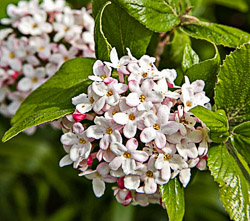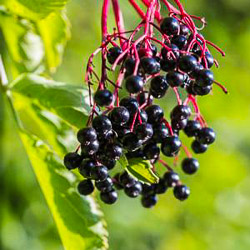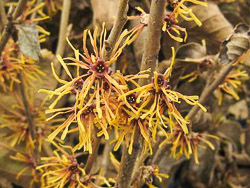
Viburnum carlesii
You can have flowering plants in all seasons! Yes, it is hard to imagine a garden with flowers almost all year long, but, really, it isn’t so hard. Soon, I hope, it will be spring, with a myriad of choices for blooming plants. One of my favorites is Viburnum carlesii, the koreanspice viburnum. The shrub, growing to about 8 ft high and 8 ft wide, is deer resistant and thrives in average soil conditions. Not only will it grow in partial to full shade, but it has the added attraction of fall color in reds and burgundy. The flowers appear in mid-spring‚Äîbeautiful balls of creamy white with a wonderful fragrance. Not only that, but the plants are purported to grow under black walnuts. What an all-around winner!
If you want color in a spring bloomer, look no further than Chaenomeles ‚ÄòCameo,’ the flowering quince. The beautiful peach-pink flowers open in late April and then develop fruits that persist into fall. The plants enjoy full sun but will adapt to part shade and are happy in average soils. They are deer resistant and the fruits are a great food source for wildlife. Or, in the fall, cut the branches with fruits, and bring them inside. They have a lovely scent!

Sambucus canadensis ‚ÄòAdams’
Later, in June and July, look for Sambucus canadensis ‚ÄòAdams’ to bloom. ‚ÄòAdams’ American elder is a selection of a native plant that grows in clumps. Not only do you get lovely flowers, but in August and September the fruits develop. The fruits will add a splash of purple to the garden, and are also edible. If you don’t harvest them to make jam, the wildlife will be happy to eat them for you. The plants are tolerant of average soils, both wet and dry, and sun to shady conditions, so these plants will grow almost anywhere.
In summer, Hydrangea paniculata ‚ÄòFire and Ice’ comes into its own. The flowers form a lovely cone shaped panicle of white when they open in June and July. But Wait! As they age, the flowers develop a deep rose to red color. As the weather cools, the color becomes more intense. The plants do well in both full sun and partial shade, and a backdrop of other green plants will make the flowers shine. At maturity, you will have a lovely 8 ft. high plant, that spreads to 6 ft.
Camellia oleifera ‚ÄòLu Shan Snow’ is a good choice for a fall blooming plant. It has lovely, single white flowers on evergreen foliage. This is a very cold tolerant camellia that will grow to a height of 6 ft with a 5 ft spread. The plants will grow in full shade, making them a nice addition to the shade garden, but will also tolerate some sun. What a spectacular addition to the fall garden!
Fall really highlights foliage colors and berries. While Callicarpa dichotoma ‚ÄòDuet’ blooms in summer, the flowers are small and not exactly breathtaking. It is the white berries that develop in the fall that really make it special. In addition, the ivory and green variegated foliage makes it stunning throughout the growing season. The berries are an attractive accent to the fall garden and a food source for wildlife. The plants are deer resistant.

Hamamelis vernalis Autumn Embers
Let’s end with one selection for‚Äîwinter! Depending on the severity of the winter, Hamamelis vernalis Autumn Embers, vernal witch hazel, will be blooming in February and March. The blooms are a beautiful orange, with the added benefit of being fragrant. Not only are the flowers a lovely addition to the winter garden, but the plants are both salt and wet-site tolerant. Definitely a plus this winter season! In addition, fall colors of yellow-orange to red-purple will give your garden a lift. You definitely can have blooms in all seasons!
==Marla Jackson
